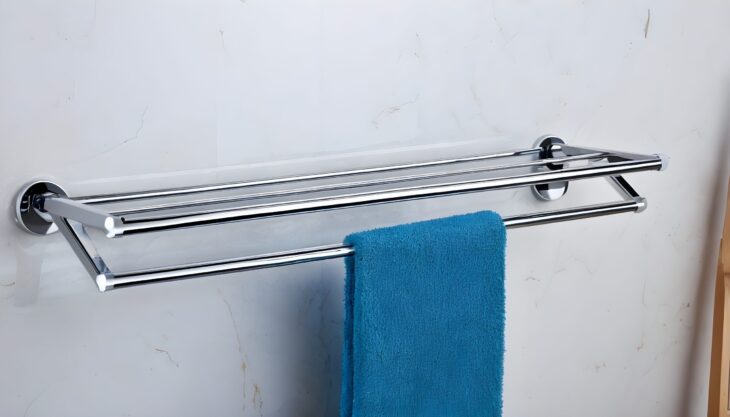Understanding Heated Towel Rails
In addition to providing a nice touch to bathrooms, heated towel rails may also be used as a potential drying rack for clothes. They keep your towels toasty warm. One typical question that arises from their convenience is if wet garments can be placed on a hot towel rail. Heated towel rails function similarly to radiators, producing heat with the use of electricity or hot water. There are several varieties to choose from, including as dual-fuel, hydronic, and electric. Since each type has distinct qualities, it can be used in a variety of circumstances and preferences. Heated towel rails are bathroom accessories that warm the bathroom while also heating towels. These handy devices, which are usually powered by electricity or connected to the central heating system, offer a luxurious touch to bathrooms by conveniently drying and warming towels. Different aesthetic tastes are catered to by the variety of designs available for these rails, which range from sleek, modern styles to classic radiators. Their longevity and moisture resistance are ensured by the use of materials like chromium or stainless steel in their construction. Utilizing already-existing heating systems, heated towel rails can run without the central heating during the warmer months, further contributing to energy savings. They add comfort and, in humid situations, keep mold and mildew from growing because of their warmth.
Can You Put Wet Clothes on a Heated Towel Rail?
While garments can be successfully dried by hot towel rails, there are a few things to consider. It is crucial to select materials that take well to low temperatures and to keep the rail from being overloaded. It is possible to use a heated towel rail to hang damp clothing. Towels and other materials can be effectively dried and warmed with the help of heated towel rails. The warmth produced by the rail facilitates faster moisture evaporation from wet clothing, speeding up the drying process. To have the best air circulation, clothes must be spaced appropriately apart. To ensure that every item dries properly, don’t jam too many items onto the rack. In the winter, when traditional drying may take longer, heated towel rails come in handy.
Advantages of Using Heated Towel Rails for Drying Clothes
They are a desirable alternative for people looking for convenience without sacrificing sustainability because of how quickly they operate and how energy-efficient they are in comparison to conventional drying techniques.
Effective Drying: By creating a warm atmosphere that promotes moisture evaporation, heated towel rails hasten the drying process of clothing.
Energy-Efficiency: They are an energy-efficient choice for drying garments because they frequently run on already-existing central heating systems.
Versatility: Drying a variety of materials, such as towels, socks, and delicate clothing, is possible with heated towel rails.
Prevention of Mold and Mildew: Particularly in moist areas like restrooms, the warmth produced aids in preventing the formation of mold and mildew.
Precautions and Guidelines
Some safety measures need to be followed in order to guarantee that heated towel rails operate at their best. Because different textiles react differently to heat, it’s best to confirm compatibility by consulting the manufacturer’s specifications. Aside from preventing any damage or risks, being aware of the rail’s weight capacity is also important.
fitted by Experts: To ensure correct electrical or plumbing connections and adherence to safety regulations, make sure heated towel rails are fitted by certified experts.
Appropriate Spacing: To ensure proper air circulation and effective drying without sacrificing safety, avoid packing the rail too full.
Temperature Control: Pay attention to the parameters to avoid overheating and possible harm to materials or the rail itself.
How Long Does It Take for Clothes to Dry on a Heated Towel Rail?
Lighter materials often dry more quickly, taking anywhere from 30 minutes to several hours on average.
varies by Fabric Type: Depending on the type of fabric, a heated towel rail will take a different amount of time to dry; lighter materials will dry faster than heavier ones.
Ideal circumstances: Clothes and towels may usually be dried on a heated towel rail in a few hours when the right circumstances are met.
Room Temperature: The overall temperature of the room has an impact as well; warmer rooms typically result in quicker drying periods.
Appropriate Spacing: Ensuring adequate space between objects on the rail promotes improved airflow and more effective drying.
Humidity Levels: A room with lower humidity promotes faster evaporation, which speeds up the drying process.
Alternatives for Drying Clothes
Although heated towel rails are a practical option, there are other ways to dry garments as well, particularly if the rail is in use or not available. It is possible to air dry, use a conventional drier, or use other warm surfaces.
Traditional Clothesline: Using natural sunshine and air movement, hanging clothes outside on a clothesline is a time-tested and energy-efficient technique.
Indoor Drying Rack: Using ambient heat and air, wall- or portable-mounted drying racks offer a compact solution for drying garments indoors.
Electric or Gas Dryers: For people with limited outdoor area, modern machines such as electric or gas dryers provide quick and effective drying.
Spin dryers: Compared to traditional drying techniques, these small devices spin extra water out of clothing, saving time and energy.
Common Misconceptions
Items that can only be cleaned by dry cleaning: Contrary to popular assumption, depending on the fabric, certain goods marked “dry clean only” can really be safely hand-washed or laundered. Cleaner Clothes with Greater Detergent: Excessive detergent use can actually damage materials and leave residue behind, not to mention that it doesn’t always make garments cleaner. Sweater Hanging Causes Straying: Sweaters can avoid stretching and keep their shape when hung correctly, utilizing techniques like folding them over hangers. Sunlight Eliminates Every Stain: Sunlight is not a foolproof stain remover; some stains may need special treatment. However, it can help fade certain stains. Better Performance Is Equal to Fabric Softener: Fabric softener mainly gives clothes a nice smell and soft feel; it doesn’t improve cleaning.
Maintenance Tips for Heated Towel Rails
Items that can only be cleaned by dry cleaning: Contrary to popular assumption, depending on the fabric, certain goods marked “dry clean only” can really be safely hand-washed or laundered.
Cleaner Clothes with Greater Detergent: Excessive detergent use can actually damage materials and leave residue behind, not to mention that it doesn’t always make garments cleaner.
Sweater Hanging Causes Straying: Sweaters can avoid stretching and keep their shape when hung correctly, utilizing techniques like folding them over hangers.
Sunlight Eliminates Every Stain: Sunlight is not a foolproof stain remover; some stains may need special treatment. However, it can help fade certain stains.
Better Performance Is Equal to Fabric Softener: Fabric softener mainly gives clothes a nice smell and soft feel; it doesn’t improve cleaning.
Choosing the Right Heated Towel Rail for Drying Clothes
When choosing a heated towel rail, it’s important to take into account aspects like installation requirements, size, and extra functions. To provide users more control over the drying process, several rails have timers or temperature settings that may be adjusted.
Think About Size and Capacity: Select a heated towel rail that is big enough and has enough space to hold all the items you usually need to dry.
Power Source: Depending on your preferences and the infrastructure you already have in place, choose between piped and electric alternatives. Electric choices offer greater placement flexibility.
Composition and Glaze: For materials that are long-lasting and moisture-resistant, choose chrome or stainless steel, and make sure the finish matches the style of your bathroom.
Real-life Experiences
Gaining important information from hearing about people’s experiences drying clothing on heated towel rails is a worthwhile endeavor.
Convenient Drying Solution: Especially in the winter, my heated towel rack has made drying wet towels and clothing in my bathroom incredibly easy.
Energy economy: By making use of pre-existing infrastructure, the heated towel rail’s connection with the central heating system demonstrated energy economy while also providing warmth.
look Enhancement: The towel rail’s elegant form not only fulfills a practical need but also elevates the bathroom’s overall look, creating a cozier, more fashionable atmosphere.
Environmental Impact of Using Heated Towel Rails for Drying Clothes
It is crucial to take the surroundings into account. Even though heated towel rails use electricity, their ability to dry garments fast can help reduce overall energy use when compared to other drying techniques.
Energy Economy: Electric or linked into pre-existing central heating systems, heated towel rails can save energy and lessen their negative effects on the environment.
Decreased Laundry Load: Drying quickly and effectively on heated towel rails may reduce the frequency of washing, which will conserve water and detergent.
Seasonal Adaptability: Drying clothes can be done in a more adaptable and resource-conscious manner when heated towel rails can be operated independently during the warmer months.
Conclusion
Finally, heated towel rails are multipurpose fixtures that fulfill opulent as well as utilitarian needs in homes. They are a practical substitute for conventional drying methods for quickly drying wet items when used sparingly and in accordance with stated instructions. In conclusion, drying damp garments over a heated towel rail is often practical and effective. Particularly in the winter, the rail’s soft warmth helps to expedite the drying process, making it a practical option. To prevent any potential damage, it’s crucial to take the clothing’s material and the manufacturer’s instructions into account.


[…] Post Views: 2 Previous postwhy do Europeans use towel warmer? Next postCan you put wet clothes on a heated towel rail? […]
[…] Can you put wet clothes on a heated towel rail? […]